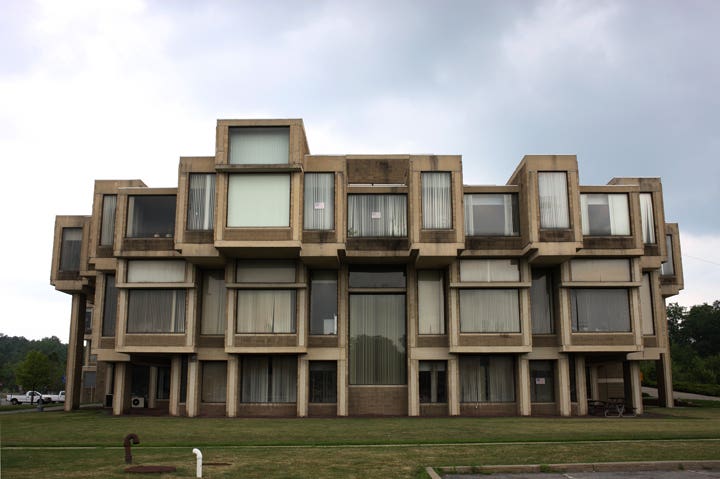
Clem Labine
Taxpayer Revolt Adopts Preservation’s Reasoning
An abandoned building in the village of Goshen, NY, is in the middle of a strange battle over whether the structure should be restored or torn down. What makes this fight unusual is the way opposing sides line up: Context-sensitive preservationists are on the side saying “tear it down,” while among those urging the building’s preservation is a taxpayer group that normally has little interest in historic architecture.
The building at the center of this controversy is the Orange County Government Center situated on Goshen’s Main Street. The structure was completed in 1971 to a design by then-starchitect Paul Rudolph and is considered by many to be a masterpiece of the Brutalist style. The World Monuments Fund has even placed it on its watch list of threatened cultural heritage sites in need of protection.
Although considered an architectural icon by acolytes of Modernism, in many ways the Government Center is a hard building to love. For openers, it is despised by many local residents because it is so out of character with the prevailing architectural context of the community, which consists largely of vernacular buildings from the eighteenth to the early twentieth century. So when Edward A. Diana, the executive for Orange County, declared that he wanted to demolish the structure, many local residents cheered him on.
Diana’s decision was not based primarily on architectural taste, however, but rather on operational and maintenance problems. The Rudolph building has 87 individual flat roofs, which have been prone to leaks since the building opened. The many changing levels of the interior mean it is not friendly to the disabled, and the single-glazed windows make the building expensive to heat and cool. The last straw occurred last September when heavy rains flooded the basement and the building was evacuated permanently. Diana sees the structure as one big maintenance headache and wants it torn down to be replaced by a new, larger structure that is more in keeping with the town’s architectural character.
Environment v.s. aesthetics
The current dispute is whether it is more cost effective to renovate and expand the 1971 building or to tear it down and replace it. A preliminary report by the county estimated that a new, larger building would cost $136 million, while a renovation of the Rudolph building would run $67 million. However, the taxpayer group disputes the projections, claiming that the costs of an entirely new complex are under estimated, while the estimates for renovating the old building are inflated.
Most interesting of all is the way the taxpayer group also embraces the language of sustainability and environmental costs in making the case for recycling the old building.
Myrna Kemnitz, a county legislator, puts it this way: “We must contemplate a realistic cost of asbestos detection, abatement and containment for this building. If there is asbestos in the concrete, in concrete is the best containment place for it to remain. Then there is the charge for cartage of the rubble to a landfill and the reckoning of the space it will take up, and restoration/renovation uses far less energy than tearing down and building anew. Environmentally, retrofitting is far kinder than demolishing and building anew.”
It is heartening to see the language of sustainability being injected into mainstream discourse. For me personally, if environmental costs were not a factor, I would gladly urge the demolition of the existing Rudolph building. Yes, it is a historic architectural artifact. But it was a mistake to place such an aggressively non-contextual building in that picturesque town in the first place. As Steve Semes argues so persuasively in his new book, The Future of the Past, preserving the existing special character of a place should be the primary factor guiding any new construction in older neighborhoods.
But as legislator Kemnitz points out, we’re not starting with a clean slate here; hundreds of tons of concrete have already been poured. So if we believe all the things we say about adaptive reuse, embodied energy and recycling old buildings, I reluctantly conclude that the environmentally responsible thing to do is see if there are cost-effective ways the 1971 Rudolph building can be reused. Globally, we’ve reached a point where environmental costs trump aesthetic taste.
Clem Labine is the founder of Old-House Journal, Clem Labine’s Traditional Building, and Clem Labine’s Period Homes. His interest in preservation stemmed from his purchase and restoration of an 1883 brownstone in the Park Slope section of Brooklyn, NY.
Labine has received numerous awards, including awards from The Preservation League of New York State, the Arthur Ross Award from Classical America and The Harley J. McKee Award from the Association for Preservation Technology (APT). He has also received awards from such organizations as The National Trust for Historic Preservation, The Victorian Society, New York State Historic Preservation Office, The Brooklyn Brownstone Conference, The Municipal Art Society, and the Historic House Association. He was a founding board member of the Institute of Classical Architecture and served in an active capacity on the board until 2005, when he moved to board emeritus status. A chemical engineer from Yale, Labine held a variety of editorial and marketing positions at McGraw-Hill before leaving in 1972 to pursue his interest in preservation.








